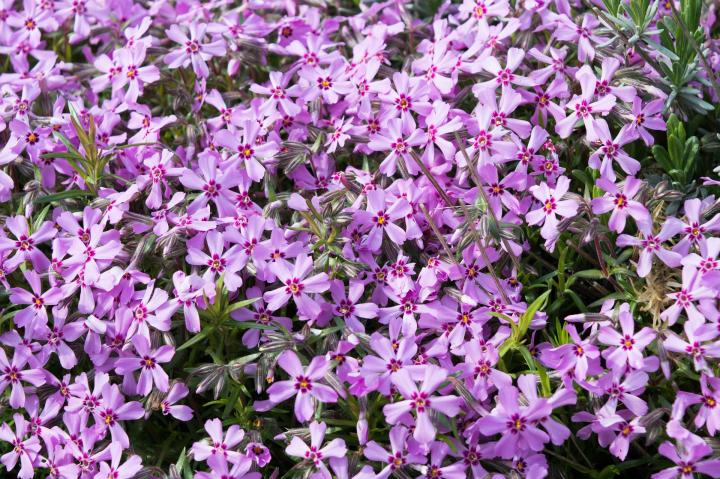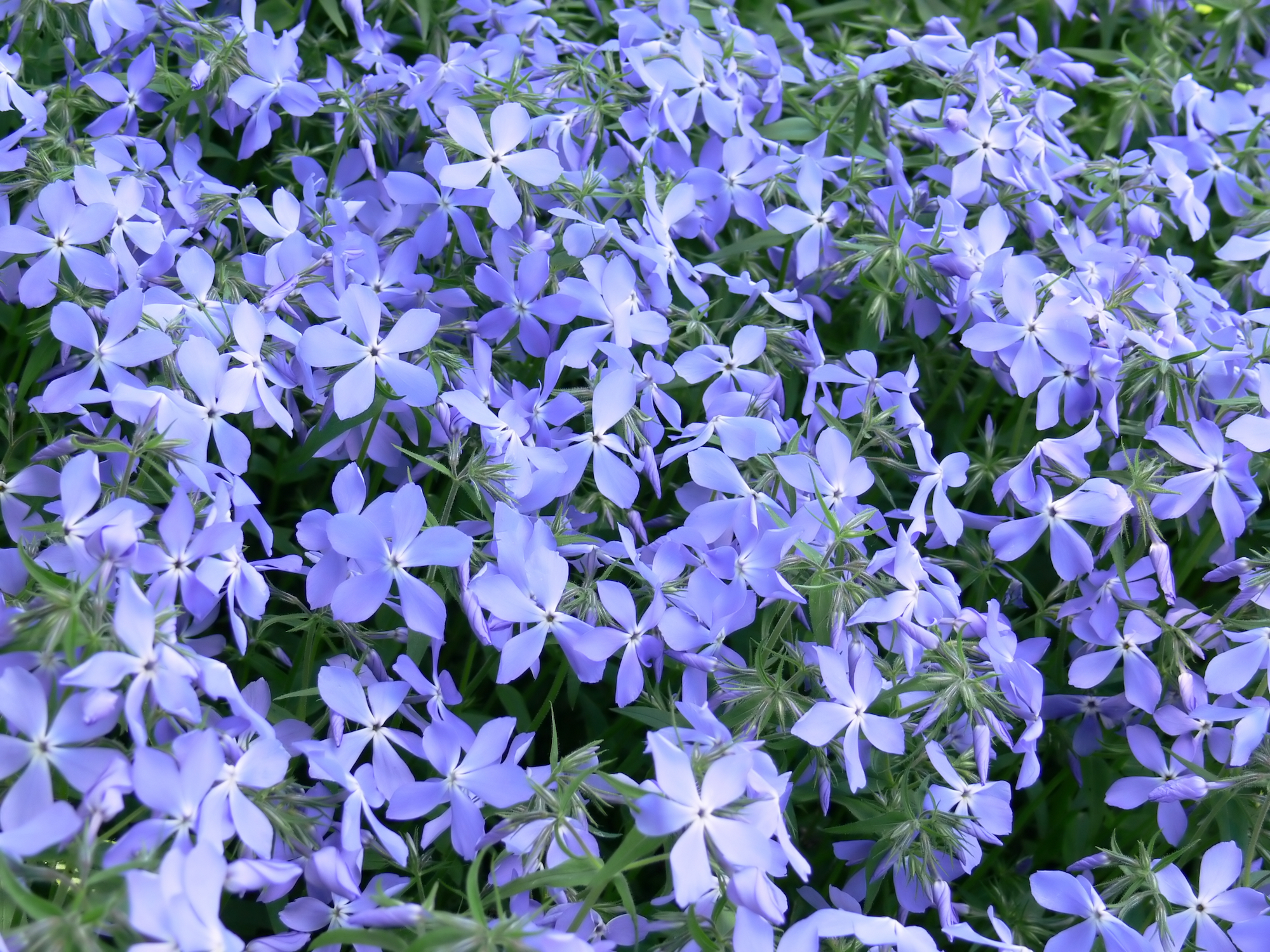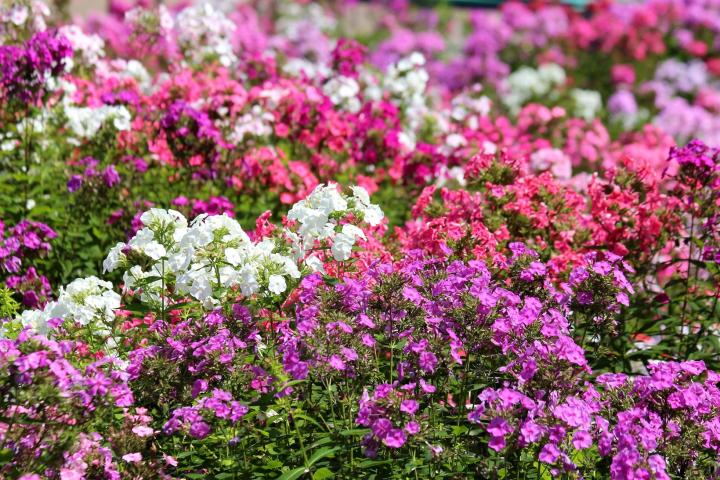
From Ground Covers to Garden Giants: Meet the Many Faces of Phlox
Types
You just can’t go wrong with phlox! Here are some of the best species and varieties to try:
Low-Growing Phlox
- Creeping phlox or moss phlox (Phlox subulata) is a low-growing species that works excellently as a ground cover. It spreads slowly, growing in mounds that get 4–6 inches thick. The whole plant turns into a carpet of color in spring, when flowers cover every square inch of foliage. This phlox is particularly stunning when allowed to drape over a rock wall—imagine a waterfall of color! Creeping phlox grows best in well-draining soil and partial to full sun.
- ‘Candy Stripe’ is a popular variety with pink-and-white–striped flowers.
- ‘Emerald Blue’ produces a sea of lilac-blue flowers (perfect for that waterfall of color!).

- P. stolonifera, which also goes by the common names creeping phlox and moss phlox, is similar to P. subulata in name only. The main differences between it and P. subulata are that its leaves are oval-shaped (rather than needle-shaped), and its flowers are produced on stems that rise 6–10 inches above the foliage (rather than directly on the foliage). It prefers a shadier growing site with rich, evenly moist soil.
- ‘Sherwood Purple’ is a delicate little phlox with purplish-pink flowers.
- Woodland phlox or blue phlox (P. divaricata) is another low-growing species. As its two common names suggest, it prefers partial to full shade and moist, rich soils and produces bluish flowers in early spring. Like P. stolonifera, its flowers bloom on stems that rise about a foot or so above the creeping foliage.
- ‘Chattahoochee’ and ‘Blue Moon’ are two great varieties with beautiful blue-to-violet flowers.

Medium-Height Phlox
- Annual phlox or Drummond’s phlox (P. drummondii) grows as an annual rather than a perennial, unlike most other phlox species. Annual phlox rarely grows taller than 2 feet in height. Most varieties are not very heat tolerant, but in warmer regions, you may find the heat-tolerant varieties for sale. Plant in well-draining soil in a site that gets partial sun and doesn’t stay too wet.
Tall Phlox
- Garden phlox or summer phlox (P. paniculata) is the tallest phlox in cultivation and is probably the species that most folks have in their gardens. It grows in clumps that reach between 3 and 5 feet in height and produces panicles of flowers in mid- to late summer. Though tolerant of most lighting, it grows and flowers best in partial to full sun. It has a reputation for being very susceptible to powdery mildew, but resistant varieties are available.
- ‘David’ has bright white flowers and is resistant to powdery mildew.
- ‘Jeana’, another mildew-resistant variety, produces panicles of petite purplish flowers—similar in appearance to a butterfly bush.
Other Phlox
The phlox listed above are just a few of the many species out there. Others of interest to gardeners may be Carolina phlox (P. carolina), meadow phlox or spotted phlox (P. maculata), and sand phlox (P. bifida).
If you have used fertilizer, you added too much or it could be run off from fertilizing another plant but I've seen that with my cosmos. I fertilize something else and it ran off into my cosmos and that's how they looked. I betcha that's it. That's how it grows down here in Texas.
To answer the question about flox in a container, knowing how fast those roots travel, my guess would be the flox are crowded.
I live in Maine, by the ocean. This is the second year something has eaten the top of my Phlox. What is doing it?
Barry. Many of my phlox also don't have the bottom leaves. I suspect it is either slugs or black vine weevils, both of which come out at night. Slugs in particular munch the whole leaf away. I hunt them with a headlight at night, and capture them in folded up landscape material in the day.
One of my phlox plants, growing in potting soil in a large pot, each year loses its lower leaves. The leaves turn yellow and fall off. A plant pathologist could not identify any insect or mildew affecting the plant. I have tried to limit watering, sprayed with insecticde/fungicide, and divided the plant. The plant has been growing in partial shade but now moved now to full sun. The plant has been blooming but on largely leafless stems. Any thoughts?
I have phlox and I find stems laying on ground
if you mean that the stems collapsed it could be that they are getting too much water from you or from Mother Nature. If you don’t think so, it may be that the soil is retaining water; it is not running off or being absorbed into the ground. ANd/or it may be that mulch is retaining moisture and is up against the stems.
In the spring do you cut back the dead creeping phlox to Allow regrowth
Cutting back is generally recommended earlier in spring, but do it now if this is your best time. Also see above.
You never say what fertilizer, since we have low blooming, or creeping phlox. Is full sun preferred, or can thy have some shade??? In Western Pennsylvania. Our first attempt. THNX...









